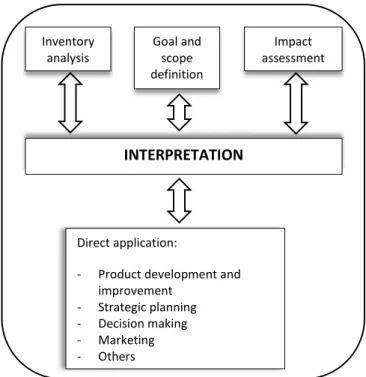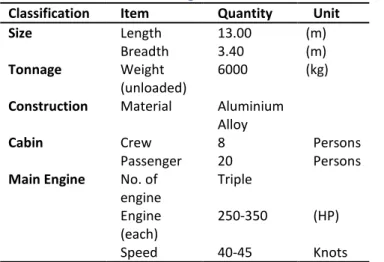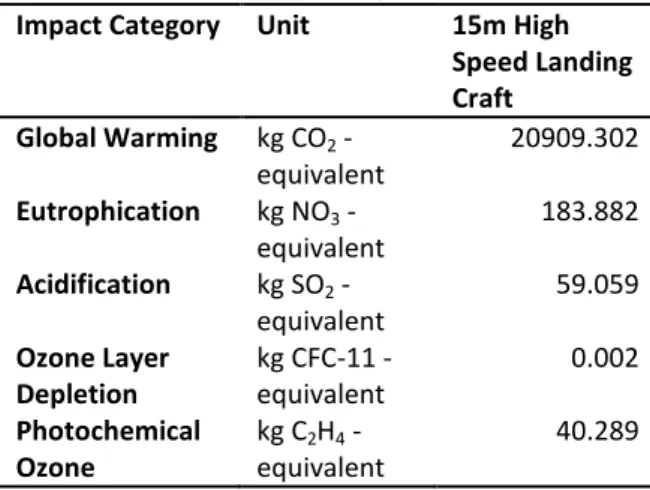I
NVESTIGATION OF
P
RODUCT
L
IFE
C
YCLE OF
S
MALL
C
RAFT
M. Z. M. Kamal,
aY. Samian,
a,*a
Department of Aeronautical,
Automotive and Ocean Engineering,
Universiti Teknologi Malaysia,
81310 UTM Skudai, Johor.
Article history Received
07 May 2015
Received in revised form
05 July 2015
Accepted
12 August 2015
*Corresponding author
yahya@fkm.utm.my
K
EYWORDSLife Cycle Assessment (LCA); emission;
environmental impacts
I
NTRODUCTIONIn Malaysia, there are only some marine companies which perform product life cycle research for their ships due to the lack of awareness and knowledge. At a shipyard, each produced ship is certain with negative effects to the environment, therefore solution is necessary to lessen these effects. This study considered the ship type and size dependent input data for emission modelling.
Life Cycle Assessment (LCA), under ISO-14040, is an effective tool for measuring and evaluating the burden of products, including effects of the environment during their entire life cycle; from extraction of resources, to the production of materials (product and its parts), then to use of the product to the management after it is discarded, either by reusing, recycling or final disposal. The model in the ISO standard divides the entire LCA procedure into four phases:
(1) Goal and scope definition (2) Inventory analysis (3) Impact assessment, (4) Interpretation [1].
This research proposes an LCA methodology specific to crafts below 20m and calculation to facilitate LCA analysis of craft. It starts with life cycle inventory (LCA) analysis, in which the life cycles are, as far as possible, compiled and quantified, focusing on carbon dioxide (CO2),
nitrogen oxide (NOx), sulphur dioxide (SOx) and
other emissions. Detailed investigations are usually conducted on extraction of resources through the production of materials and construction at shipyard in order to estimate environmental impact.
A
BSTRACTL
ITERATURER
EVIEWEnvironmental issues have never been higher on the shipping agenda. Today’s marine industry is under increasing pressure to comply with evolving regulations; to become cleaner and greener. Environment issues such as acid rain, hazardous emission to air, water and soil compartments, and improper waste management are now widely discussed for improvement. Examples of the critical issues are climate changes and air pollution. While climate change and air pollution grab the headlines, there is a host of other environmental challenges to be met, such as sulphur oxides (SOx) reductions and nitrogen
oxides (NOx) emissions, ship recycling and ballast
water management.
Nevertheless, in perspective of climate change, ships offer many advantages due to their high energy-efficiency in transportation goods. However, the emission of greenhouse gases from this source is projected to increase by large amounts over the coming years. In addition, the shipbuilding industry suffers from significant environment concerns in many other areas. Discharge of hazardous contaminants to waterways, marine ecosystem and food chains are direct attributes to many activities in the industry, with risks of environment damage generally being elevated by the industry with open air environment and water front locations, as these provide direct pathways for pollutants to reach air, soil and water.
Air pollution from shipping has been increasing over the last 10 years. Emissions of nitrogen oxides from international traffic in the North and Atlantic Sea, for example have increased by more than 20% in 1998-2007 reaching [2]. Recently, adopted strict International Maritime Organization (IMO) emissions control standard is expected to help reduce emissions progressively. Improved practices and innovative technologies for ship at port and seas need to develop to further reduce atmospheric deposition of NOx, SOx particulate
matter and green gases [2].
Shipping also has environment impact at ports, as well as in immediate vicinity of the ports. Examples of these impacts are noise from ship engine and machinery used for loading and unloading, exhaust of particles, carbon dioxide (CO2), NOx, SOx from
ship and auxiliary engines and dust from handling of substances such as grain, sand and coal. Therefore, designer and engineer face a challenge
to improve environment performance, where new knowledge and new strategy are combined to develop a method to improve various aspects of ships [2].
Terminology
Definition of Life Cycle
Life Cycle is defined as duration of a product, beginning with extraction and proceeds through material processing, manufacturing, use and its ultimate disposal [3].
A new product progresses through a sequence of stage from introduction to growth, maturity and decline [4].
Various aspects of life cycle (LC) activities are addressed as A (assessment), E (engineering), D (development) and so on.
Definition of Life Cycle Assessment (LCA)
A life cycle assessment covers all environmental impacts results from making, using, and disposing of materials and products we buy. This assessment includes all energy and raw materials used and the environmental consequences of each stage of development [5].
The life cycle assessment analyses the effects of a product on the environment during its entire existence, from productions to its period of use and its end-of-life recycling. It is a quantitative evaluation of ecological aspects, such as the emission of greenhouse gases (including carbon dioxide, CO2) energy consumption, acidification or summer smog [6]. LCA facilities the study of the environment aspects and potential impacts throughout life cycle of a product from being raw material, followed by production, usage and disposal [4].
History of Life Cycle Assessment
Life Cycle Assessment Framework
The LCA framework is based primarily on ISO 14040 (2006). The following figure illustrates the framework and application of LCA, also outside the framework.
Figure 1: Phases of LCA [8]
M
ETHODOLOGYIntroduction
The steps in life cycle assessment are:
1. Identify the types of impacts being considered in research
2. List the environmental impacts
3. Select suitable and particular small craft as a case study
4. Ensure the selected craft provide useful data to perform analysis
5. Find the life cycle inventory related with assessment
6. Analysis data through the stages of life cycle
7. Perform the assessment for environmental impact of small craft
8. Discuss the impact based on International Organization Maritime (IMO) guidelines
Analysis Procedures
Analysis procedures in life cycle assessment involve 8 aspects, as shown in Figure 2 below:
Figure 2: Flow of assessment
Impact Categories
The classification section describes which flows contribute to each impact category. In the characterisation step, the contributions of the different flows to each impact category are aggregated. This aggregation is based on a traditional scientific analysis of the relevant environmental processes. In this project, the following characterisation categories have been chosen.
Acidification
Calculation of acidification in term of kg SO2 equivalents corresponding to mi kg of a significant component i is analogous to the computation of the pollutant potential:
Acidification [kg SO2-equiv.]
= APi [kg SO2-equiv./kg] • mi [kg]
Eutrophication
Calculation of the eutrophication production of NO3-equivalents i is analogous to the computation of the pollutant potential:
Eutrophication effect [kg CO2-equiv.]
= EPi [kg CO2-equiv./kgGas] • mi [kgGas]
Global Warming
The GWPi factor may be used to assess the greenhouse effect of gas i (in equivalent kg of CO2) from the following equation:
Global Warming [kg CO2-equiv.]
= GWPi [kg CO2-equiv./kgGas] • mi [kgGas]
Goal and scope definition Inventory
analysis
Impact assessment
INTERPRETATION
Direct application:
- Product development and improvement
Ozone Depletion
In order to assess the depletion of the ozone layer (expressed in equivalent kg of CFC-11), the emitted mass of a gas mi in kg is multiplied by the ODP factor:
Ozone depletion [kg CFC-11-equiv.] = ODPi [kg CFC-11-equiv./kg] • mi [kg]
Photo-oxidant formation, Photochemical Ozone Production
Calculation of the photochemical production of oxidants for mi kg of a VOC compound i is analogous to the computation of the pollutant potential:
Production of oxidants [kg C2H4-equiv.]
= POCPi [kg C2H4-equiv./kg] • mi [kg]
C
ASES
TUDYOverview
This chapter discusses about the case study on 13m High Speed Landing Craft constructed by Marlin Marine Sdn. Bhd, whose shipyard is located at 5892, Tanjung Agas Industrial Area, 84000 Ledang, Johor. This case study covers selection of the small craft, specification of the craft, craft construction analysis, system boundary for craft, raw materials used for building the craft, and craft construction process. The results of the case study are required for impact assessment analysis for life cycle of this craft.
Case Study: 13m High Speed Landing Craft
Table 1: Principal Particulars of the 13m High Speed Landing Craft
Classification Item Quantity Unit
Size Length 13.00 (m)
Breadth 3.40 (m)
Tonnage Weight
(unloaded)
6000 (kg)
Construction Material Aluminium
Alloy
Cabin Crew 8 Persons
Passenger 20 Persons
Main Engine No. of
engine
Triple
Engine (each)
250-350 (HP)
Speed 40-45 Knots
Landing craft is designed for both work and pleasure. It has wide drop door/ramp at the bow for easy loading and unloading of equipment, cargo or transport. The landing craft chosen for this research is a 13m High Speed Landing Craft constructed by Marlin Marine Sdn. Bhd. Since investigation of life cycle of a craft from construction until dismantling can take a couple of years to collect the data, this study only focuses on the environmental impact during manufacturing the craft. Marlin Marine shipyard has provided complete data of construction, starting from design procedure until sea trial. The principal particulars of the landing craft are shown in Table 1.
Figure 3: 13m High Speed Landing Craft
Data Specification of the Craft
Landing craft may be equipped with complete equipment of machinery, navigation and safety. Table 2 shows the details of material, weight and description of material.
Table 2: Details of 13m High Speed Landing Craft
Exchanges, 13m High Speed Landing Craft
Weight (kg)
Material inputs
Aluminium
Frame 541.55
Extrusion 28.21
Coaming plate 474.05
Chequer plate 226.74
T-Bar 124.55
Flat bar 164.32
Hull Shell 957.20
Fuel tank 400.00
Filler Wire 242.50
Main Engine 735.00
Electrical equipment 265.60
Electrical cables 10.00
Perspex 2.00
Zinc anode 6.00
PVC seat 190.00
Communication and navigation equipment
8.50
R
ESULTS ANDD
ISCUSSIONGoal and Scope
The step in the goal definition phase involves stating and justifying the goal of study, explaining the aim of the study and specifying the intended use of the result. The goal of this study is to identify the life cycle of 15m high Speed Landing Craft, but narrowed to construction period and analyzing the environmental impacts during that period.
Life Cycle Inventory: Production of Materials,
Craft Construction
Life cycle inventory, which records as many of the requisite types and quantities of material, plus as many of the types and quantities of energy needed for production, utilisation and end of life of a product as possible. Every specific life cycle inventory based on the data specification of the craft is listed in Table 2.
Inventory Analysis
For eutrophication, the photochemical ozone, acidification and ozone layer depletion was estimated using Microsoft Excel. The parameter for every environmental effect is different from each other, depending on the chemical emitted to the surrounding. The calculation of life cycle analysis was of basic method, whose calculation detail was obtained from software developer.
Result of Environmental Impact
For more deliberation on environmental matter, the Committee received information on Phase 1 of the update of the 2000 IMO Study on GHG emissions from ships, which estimated emissions of carbon dioxide (CO2) from international shipping
both from activity data and from international fuel statistics. The resulting consensus estimate for 2007 CO2 emissions from international shipping
amounted to 843 million tonnes, or 2.7% of global CO2 emissions, as compared to the 1.8% estimate
in the 2000 IMO study (Marine Environment Protection Committee (MEPC), 2008).
One of the reasons of increasing CO2 emission
involves the construction and raw materials production. Even a small craft contributes CO2
around 2 tonnes of emission. If this problem is not prevented, the emission will increase quickly for the next years.
Table 3: Overall Result Impact Assessment
Impact Category Unit 15m High
Speed Landing Craft
Global Warming kg CO2 -
equivalent
20909.302
Eutrophication kg NO3 -
equivalent
183.882
Acidification kg SO2 -
equivalent
59.059
Ozone Layer Depletion
kg CFC-11 - equivalent
0.002
Photochemical Ozone
kg C2H4 -
equivalent
40.289
Sulphur emissions (SO2) from ships' exhausts are
estimated at 4.5 to 6.5 million tons per year - about 4 percent of total global sulphur emissions. Emissions over open seas spread out and have moderate effects, but on certain routes, dense emissions create environmental problems, including English Channel, South China Sea, and Straits of Malacca [9].
In this research, exhaust diesel engine during sea trial produced around 3 kg of sulphur emission; then totalled up to 59.09 kg. This emission amount was not included during craft operation, so the charge of emitted emission by the craft was slightly higher. Small crafts usually operate for 20 years; thus by estimating production of 10 kg sulphur emission for a week, total emission per year by small craft can reach around 500 kg, which is a huge quantity.
Emissions of CFCs from the world shipping fleet are estimated at 3,000-6,000 tons - approximately 1 to 3 percent of yearly global emissions. Halon emissions from shipping are estimated at 300 to 400 tons, or around 10 percent of world total [9]. The craft in this study emitted around 0.002 kg of CFC. Small crafts do not particularly contribute much impact on the environment related to CFC emission, since most CFC is emitted by large ships.
more nitrogen oxide emissions than small craft because of their size.
C
ONCLUSIONAs conclusion, emissions by small crafts can be estimated using ship production material and craft construction material database. This research reveals that about 20909.302 kg of CO2 are
released during craft manufacture, leading to global warming. The statistical approach conducted throughout the research has been proven potential to implement for further research analysis.
The outcome from the life cycle method includes every activity related to the product starting from raw materials until construction of the craft. This study was performed to identify the life cycle of a small craft type landing craft with length of 13 meters. The processes to identify life cycle is starting from collecting data about the craft. Next process is determining the environmental impact by craft based on life cycle assessment method.
To conclude, the overall analysis has proven that the life cycle of small craft contribute significant negative impact to the environment.
R
EFERENCES[1] Michihiro, K., Katsuhide, H. and Hiroaki, T., 1998. Study on Life Cycle Impact. Assessment for Ships,
Environment and EnergyDepartment, Japan
Technical Information ServiceCorporation
[2] Katy, W., 2009. Assessment of the Impacts of Shipping on the Marine Environment, Shipping Policy, Department of Transport of the United Kingdom
[3] Guinee, J.B., Gorrée, M., Heijungs, R., Huppes, G., Kleijn, R., Koning, A., 2002. Handbook on Life Cycle Assessment: An operational guide to the ISO standards. Dordrecht: Kluwer Academic Publishers.
[4] Tee P.C., 2002. Life Cycle Design for
Refrigerator,Bachelor Degree Thesis,
UniversitiTeknologi Malaysia
[5] Winthrop Merriam, Jr., 1994. Life Cycle
Assessment, West Virginia University, Extension Specialist, 4-H programs.
[6] AUDI AG, 2011. Life Cycle Assessment-Audi looks one step ahead, Ingolstadt, Total Vehicle Development and Product Communications. [7] Young, S.B., 2005. Assessment of Environmental
Life - Cycle Approach for Industrial Materials and Products (Published doctoral thesis). University of Toronto, Canada.
[8] Qianqian, H., 2011. Life Cycle Assessment of Cruising Ship Superstructure, Master in Sustainable Development, Uppsala University, Sweden
[9] Revised Anned VI adopted October, 2008:


